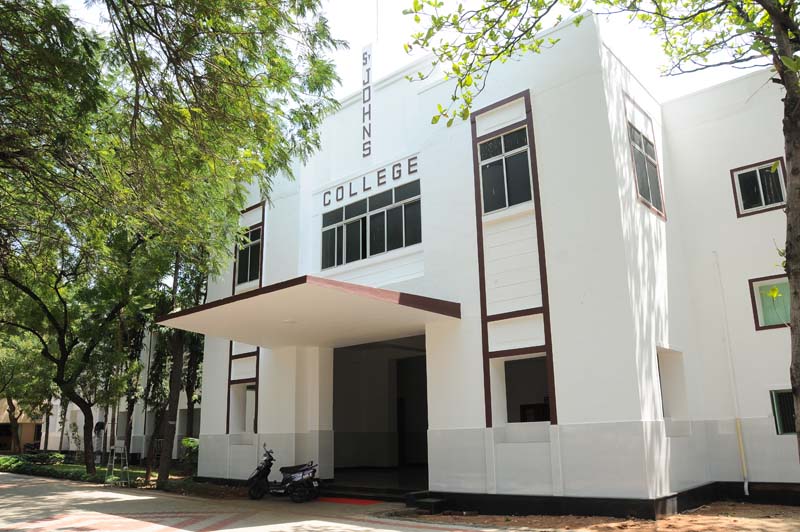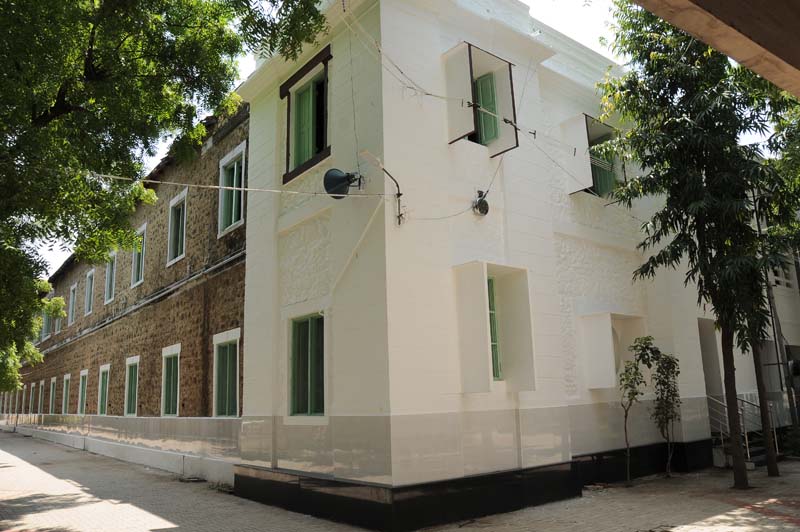
A little and unassuming Anglo-vernacular school built up by the Church Missionary Society at a leased working spot in Palayamkottai in 1844 was the minor seed from which developed St. John’s College, now a recognized foundation in the scholastic field. This school, first known as the English school and after that as the CMS School, was moved to Vannarpet in 1878, when it turned into the CM school and FA, i.e., Fellow of Arts, a two year intermediate course.
The CM College was moved to Tirunelveli Town in 1880. The missionaries in the field were quick to build up the college as a focal point of evangelization. The Rev H. Schaffter, M.A., was its first Principal and he guided the predetermination of the College for 42 years from 1878 to 1920. Rev.H.Schaffter kept the College functioning with unflagging commitment and untiring efforts.
To add to its finance related challenges, the student enrolment in the college dropped extensively. Wary ordinarily and hampered by budgetary limitations, The Rev H. Schaffter turned down a proposition in 1888 to redesign the school by presenting degree courses. The monetary position of the college turned out to be crucial to the point that the CMS parent board of trustees in London twice proposed the ending up of the school itself. Nonetheless, in 1919, the missionaries in the organization figured out how to raise a few assets to avert the emergency.

The Tirunelveli Diocese is the main Diocese in India to pioneer the reason for education in the field of organization and the board of a college. It merits calling attention to here that the Tirunelveli Church was brought into the world with 40 souls in 1780, as proved in the primary church records kept up by the Rev Bobil. The principal product of the Protestant Missionary work in Tirunelveli zone was a Marathi Brahmin widow, Kohila. She had been spared from sati and was baptized as Clarinda in 1778. The development and improvement of the congregation is firmly connected to that of this college for more than one hundred and thirty years. The college owes its presence and survival to the early missionary associations – the CMS, the SPG and the present CSI Diocese of Tirunelveli. Gradually, yet relentlessly, the student enrolment in the school demonstrated an upward pattern.
The teething inconveniences of the college were, be that as it may, in any case not through. Grants from the CMS demonstrated inadequacy, and money related guidance had to be looked for from different quarters too. The Tirunelveli Diocese moved toward the SPG church for financial assistance. The SPG promptly consented to the proposition and naturally the old name, C M College, was surrendered, and another name, St. John’s College, symbolizing its nondenominational character, was settled on.
Extension currently turned into a need and the ministers afresh needed to search for another site and they settled on the present area of the College in Palayamkottai. Regardless of solid restriction, the Rev H P Young, the second Principal of the College (1920 – 1935) did the moving of the College from Tirunelveli Town to Palaymkottai and the insight of his activity has abundantly been borne out by the trial of time. More than sixty acres of land in Palayamkottai High Grounds was gained. The establishment for the H shaped building at the present site was laid in 1925 and classes were begun here in 1928. With the most distant sightedness of the Rev Young in moving the school to this immense scope of land, St. John’s College has progressed toward becoming what it is today, with sufficient classrooms, lengthy corridors, bigger play areas, an auditorium, a great library and space for further extension.
During that time, help went to the tottering school in the individual of the Rev G T Selwyn, an English missionary who was its Principal from 1937 to 1945. Cherished by the majority in Tirunelveli, the Rev Selwyn recognized himself with the Indians and their way of life.
A huge expansion to the College amid the organization of the Rev Selwyn was a Chapel. Courses in Mathematics, Physics, Chemistry and Logics were offered under Part III of the Intermediate Course. In 1943, Malayalam under Part II and Natural Science under Part III were incorporated. The College was redesigned in 1945 and degree courses in Mathematics and Economics were offered under Part III. At the point when the Rev Selwyn became the Bishop in Tirunelveli in 1945, the College was prepared to dispatch an ambitious development program.

Thus it did in 1946, the year when Prof. J. Vedasironmani assumed responsibility as the main Indian Principal of the College. In 1955, University courses were revamped with the presentation of the one-year Pre-college course and three-year degree courses. In 1957, the school anchored alliance in Physics and in Chemistry as significant subjects under Part III of the B.Sc. degree course. Later, association for Botany (1959) and Zoology (1963) B.Sc. degree courses were acquired.
Prof. Vedasironmani’s time of organization picked up tastefulness with the development of the Chemistry and Physics blocks and three private hostels, in particular Bishop Selwyn Hostel, St. Paul’s Hostel and St. Diminish’s Hostel. In 1960, the school made an inside and out buy of the northern block of the H formed building from St. John’s High School, and the High School was moved further east.
In 1962, the two wings were associated by a long passageway, and a roomy library on the ground floor and an auditorium upstairs were worked between the two wings. The University Grants Commission and the Central Government contributed liberally towards making these upgrades conceivable. In 1966, St. John’s College turned into a subsidiary College of the Madurai Kamaraj University. B.A. degree course in History and M.Sc. degree course in Mathematics were begun in 1967.
Amid the administration of Prof. D A Thangasamy (June 1969 – 1973), B.A. degree course in English Literature was presented in 1969, and M.A. degree course in English Literature in 1971. A private corridor for post graduate girl students, Sharon Hostel, was worked in August 1973 with UGC’s help.
When Prof. E. D. Ponnudurai accepted charge as the Principal of the College in October 1973, the College experienced as each College did around then, the most exceedingly awful money related emergency. The emergency kept going until 1977, when the State Government consented to give cent percent give towards the pay rates of the educating and the non-teaching staff. Amid this emergency Prof. E. D. Ponnudurai undertook strenuous endeavours to increase the money related assets of the College. His endeavours in this bearing helped put the accounts of the College on secure establishments.
Amid the tenure of Prof. T. Pandian Thanasingh (1985 – 1993) as the Principal of the College, PG Mathematics Block was built in 1986. The principal floor of Sharon Hostel and the Zoology Museum Building were built in 1992. M.Sc. furthermore and M.Phil.in Zoology were presented in 1986 and 1988 individually. In 1990, the s College got subsidiary to the recently settled Manonmaniam Sundaranar University, Tirunelveli. Further, Self-Financed Evening Course, B.Sc. Software engineering was begun in 1992.
At the point when Dr. J. Balasingh took up the reigns of the organization of the College in 1993, there was a noteworthy development on the eastern side of the grounds. It was embellished with a stately UGC Aided Centenary Block lodging the English Department, Seminar Hall and a Research Laboratory. The College Chapel which can suit 400 people for worship was developed. Self-Financed Evening Course B.Sc. Electronics was begun in 1998. The upgrading of the Department of Zoology to a Research Centre was one more noteworthy achievement in the progress of this renowned establishment. Buildings only for unaided courses, the Zoology Research Center and the Counseling Center were additionally built and they are a fillip to improve the personality of the students.
Dr. R. K. Jacob assumed charge as Principal of the College in October 2004, after the retirement of Dr. J. Balasingh. Co-education framework was presented for all college classes from the scholarly year 2005-2006. The hotly anticipated M.Sc. Physics and M.Com courses were begun in 2006. The Postgraduate Department of Botany was conceded the status of Research Centre by the University from 2007. M.Phil. Research programmes in English and Mathematics were begun from 2007. The UGC-supported career-orientated extra course in ‘Business enterprise’ was propelled. Shift system was presented from the scholarly year 2007-2008. In like manner, aided courses were directed from 8:00 am to 1:00 pm and Self-Financed Courses from 1:15 pm to 6:15 pm.
Dr. R. K. Jacob’s term as the Principal was trailed by the genuine administration reached out by Dr. Ida. P. Joseph who filled in as the Principal from 2009 – 2013. And after that Dr. Maraikumar Chellaraj accepted Charge as the Principal in 2013.
By and by, Dr. S. John Kennady Vethanathan, assumed control as the Principal on June 24, 2016. As a well-wisher of the organization, Dr. S. John Kennady wishes to build up the school as a more presumed one with the help of the educators.
St.John’s College – Documentary Video





